Why You Should Never Cover Cheesecake When It's Still Warm
Cheesecake feels like a special occasion dessert — it is so lush with its cream cheese and sweet flavors. However, it is so hard to make from home that it's difficult to imagine someone pulling out a slice every Friday night and indulging in it like an end-of-the-week pizza! But if you are a hard-core cheesecake fanatic, this may very well be the case, and you may be on the hunt for the best tips and tricks to making your own delicious cheesecake.
There are quite a few hurdles to leap over when it comes to baking this infamous cake — the crumb is known to crack at the top, become soggy if the bain-marie goes haywire, or deflate like a week-old balloon, as per All Recipes. There are a lot of ways your cake could go wrong while baking, but no one ever talks about what could go wrong after! Your cheesecake is not completely safe once you pull it out of the oven.
Cool it!
If you've ever had the pleasure of watching the Great British Baking Show, you've learned by now that no one likes a soggy bottom (via Facebook). And although a classic cheesecake has that absolutely wonderful graham cracker crust to stabilize the bake, it is not immune to becoming soggy. According to Taste of Home, if your cheesecake is not totally cool by the time you cover it and place it in the fridge, it will begin to collect condensation and ruin all your hard work.
So, what's the best way to cool your bake? Robust Kitchen advises placing the cake on a cooling rack for a minimum of two hours after you pull it out of the oven. If you touch the sponge and it still feels like it is radiating any kind of heat, the cake has not completely cooled and you should leave it out until it is no longer warm to the touch. Then, using plastic wrap, cover it completely, and stick it in the fridge. Voila, no soggy cheesecake!

